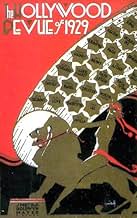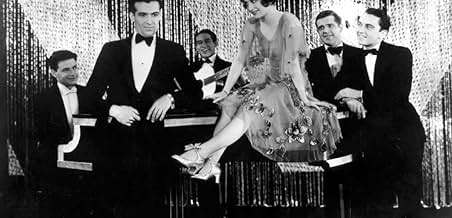AVALIAÇÃO DA IMDb
5,7/10
2,4 mil
SUA AVALIAÇÃO
Adicionar um enredo no seu idiomaAn all-star revue featuring MGM contract players.An all-star revue featuring MGM contract players.An all-star revue featuring MGM contract players.
- Direção
- Roteiristas
- Artistas
- Indicado a 1 Oscar
- 1 vitória e 1 indicação no total
Cliff Edwards
- Ukelele Ike
- (as Ukulele Ike)
Nils Asther
- Nils Asther
- (cenas deletadas)
Brox Sisters
- The Brox Sisters
- (as Brox Sisters - Singing Trio)
- Direção
- Roteiristas
- Elenco e equipe completos
- Produção, bilheteria e muito mais no IMDbPro
Avaliações em destaque
I have seen this film a few times and always think boy they were the good old days. In 1929, for their first talking film, MGM put together this lavish, all-star revue with absolutely no plot. It contains guest appearances from many of MGM's top silent film stars. If you do ever see this you will notice many of them did not make it through the transition of the talking pictures. Joan Crawford stands out doing her horrible dance and singing routine, but the best is the technicolor SINGIN' IN THE RAIN finale. This is a must for any film buff.
....suddenly it was decreed that everyone had to do one? That's what was happening in 1929, except it was naked voices, not naked bodies that were being revealed. No one could hear the stars talk, so they got to imagine what their voices were like. They also got to imagine what they were saying, or read it on the occasional title card. With sound, they heard the voices themselves and also the lines written for them. Conrad Nagel comes out sounding like the elegant gentleman he was. John Gilbert's voice is a little high pitched, (rumor has it that Louie Mayer, who hated him, had the sound track sped up), and effected. In his first film after this, he was asked to say "I love you, love you! about a dozen times during a love scene- a sequence parodied in "Singing in the Rain", and the audience laughed. Clara Bow revealed her thick Brooklynese, which seemed to belie her image as a gay party girl. Greta Garbo had a deep voice with a thick Swedish accent- just like the audience had imagined. Ben Turpin, the cross-eyed comedian, played against his image by playing swash-buckling heroes in the silents. Talkies revealed he sounded like he looked and made his films a little too ridiculous.
When you watch Hollywood Revue of 1929 and other films of that year, you are looking at some very nervous people who's recently minted stardom was threatened with extinction. And few of them made it. Those who did, like Joan Crawford, made it for reason not apparent in this musical review. In the early 30's, a deluge of stage stars like Spencer Tracy, Humphrey Bogart, James Cagney, Paul Muni, Katherine Hepburn, etc. would sweep them away and provide us with the stars of Hollywood's Golden Age.
When you watch Hollywood Revue of 1929 and other films of that year, you are looking at some very nervous people who's recently minted stardom was threatened with extinction. And few of them made it. Those who did, like Joan Crawford, made it for reason not apparent in this musical review. In the early 30's, a deluge of stage stars like Spencer Tracy, Humphrey Bogart, James Cagney, Paul Muni, Katherine Hepburn, etc. would sweep them away and provide us with the stars of Hollywood's Golden Age.
This is an amazing film, it has amazing special effects, it shows who made the transition from silent to talkie and who didn't, it has scenes in color (two-strip technicolor from what I understand), and it has some of the cutest costumes of any musical.
Some of the highlights of the movie are Joan Crawford song and dance number, which is too cute for words, and not terrible as another IMDB commenter would have you believe.
The Buster Keaton snake charmer dance is absoluetly hilarious. The Betty Johnson hiding in Jack Benny's pocket is pretty cute.
And the Singing in the Rain number is great, with it's simple yet beautiful art deco set and it's great reflective floor textured with the pitter patter of rain.
If you ever get a chance to see this film, take advantage of it. It is so strange to see every MGM start (except Garbo and Lon Chaney) in the same film, especially since many of them didn't continue making a lot of talking pictures.
Outstanding!!!!!
Some of the highlights of the movie are Joan Crawford song and dance number, which is too cute for words, and not terrible as another IMDB commenter would have you believe.
The Buster Keaton snake charmer dance is absoluetly hilarious. The Betty Johnson hiding in Jack Benny's pocket is pretty cute.
And the Singing in the Rain number is great, with it's simple yet beautiful art deco set and it's great reflective floor textured with the pitter patter of rain.
If you ever get a chance to see this film, take advantage of it. It is so strange to see every MGM start (except Garbo and Lon Chaney) in the same film, especially since many of them didn't continue making a lot of talking pictures.
Outstanding!!!!!
This is the very first of the all-star, no-plot revues that proliferated during 1929 and 1930. Just about every star at Metro is featured, and there are many fun sequences to be savored in this film. The most famous one is probably the Joan Crawford segment, where she sings and dances to "Gotta Feeling For You". Her singing is passable, and her dancing is, well, "energetic". Marion Davies seems quite nervous in her "Tommy Atkins On Parade" number, but Bessie Love is pretty good in her wild acrobatics. Marie Dressler is fun, as always, and you can glimpse Carla Laemmle as the pearl in the oyster during "Tableau Of Jewels", which opens the second half. John Gilbert's speaking voice dosen't sound nearly as bad as had been rumored, even when considering the antiquity of the recording. The "Singin' In The Rain" number is fun, and offers a good contrast to the more famous one in the film of the same name. There are some special effects and two-color Technicolor that must have wowed the audiences back then, and it's been said that during the premiere, the theater put a gallon or so of orange-scented perfume into the ventilators during the "Orange Blossom Time" finale. In all, this film is well worth a look if you are into early sound films of historical value.
This film will not get a good reception from most modern audiences, and certainly much of the film shows its seventy plus years, but this is a delight for some of us who see the '20s as a golden age, and this movie as a small window into it. It is also a humble reminder that in seventy-five years or so, what we consider entertainment will hold little or no interest to mass audiences.
If you are familiar at all with who the people are (Jack Benny, Joan Crawford, Cliff Edwards, Buster Keaton, etc.), the film is worth seeing. All of these people were one of a kind, not to be replicated by big name performers of today (great stars in their own right, but sorry, folks, they just don't have the class!). Just to see Joan Crawford as a young and beautiful woman is worth watching the film!
Technically, of course, the movie is what it says it is--a revue--intended to show audiences that their favorite silent stars can function in the new medium of sound. That purpose fulfilled (more or less), the film now might seem to have no point. The passage of time and the loss of context have made some of the humor corny (a term, by the way, from that period). The editing is clumsy (we have learned from their mistakes), but the personages themselves, and some of the song and dance, are better than anything we have today, and could not be duplicated.
I'd rather watch this than anything on the screen now.
If you are familiar at all with who the people are (Jack Benny, Joan Crawford, Cliff Edwards, Buster Keaton, etc.), the film is worth seeing. All of these people were one of a kind, not to be replicated by big name performers of today (great stars in their own right, but sorry, folks, they just don't have the class!). Just to see Joan Crawford as a young and beautiful woman is worth watching the film!
Technically, of course, the movie is what it says it is--a revue--intended to show audiences that their favorite silent stars can function in the new medium of sound. That purpose fulfilled (more or less), the film now might seem to have no point. The passage of time and the loss of context have made some of the humor corny (a term, by the way, from that period). The editing is clumsy (we have learned from their mistakes), but the personages themselves, and some of the song and dance, are better than anything we have today, and could not be duplicated.
I'd rather watch this than anything on the screen now.
Você sabia?
- CuriosidadesIn the "Singin' in the Rain" finale, Buster Keaton is shown carrying a small package in his left hand. This visual gag is a reference to Uneeda Biscuits, then a popular product made by Nabisco. The Uneeda Biscuit trademark showed a small boy wearing a yellow rain slicker and hat (similar to the outfits that the cast is wearing in this number) and walking home in the rain with a package of Uneeda Biscuits under his arm.
- Erros de gravaçãoAfter Cliff Edwards' opening number, one of the chorus girls in the background is chatting away with the girl next to her, when a sudden cut appears, and the same girl is now stone still (apparently the director told her in between to stop talking, and pay attention).
- Versões alternativasSome sources list the original running time of "Hollywood Revue of 1929" as 130 minutes. At least two sequences in the original roadshow version are missing from current prints: an opening recitation by the showgirls who are seen posing in the "Hollywood Revue" sign after the opening credits, and the appearance of Nils Asther, who assisted Jack Benny in introducing the final "Orange Blossom" number.
- ConexõesAlternate-language version of Wir schalten um auf Hollywood (1931)
- Trilhas sonorasSingin' in the Rain
(1929) (uncredited)
Music by Nacio Herb Brown
Lyrics by Arthur Freed
Played during the opening by The MGM Symphony Orchestra
Played on ukulele and sung by Cliff Edwards and The Brox Sisters; Danced by chorus
Sung by the major stars at the end
Principais escolhas
Faça login para avaliar e ver a lista de recomendações personalizadas
- How long is The Hollywood Revue of 1929?Fornecido pela Alexa
Detalhes
- Data de lançamento
- País de origem
- Central de atendimento oficial
- Idioma
- Também conhecido como
- The Hollywood Revue of 1929
- Locações de filme
- Empresa de produção
- Consulte mais créditos da empresa na IMDbPro
Bilheteria
- Faturamento bruto mundial
- US$ 5.277.780
- Tempo de duração2 horas 10 minutos
- Cor
Contribua para esta página
Sugerir uma alteração ou adicionar conteúdo ausente

Principal brecha
By what name was Hollywood Revue (1929) officially released in India in English?
Responda





































